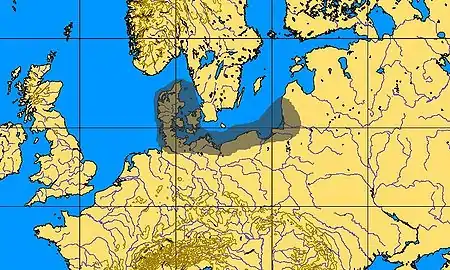Bromme culture
The Bromme culture (Danish: Brommekultur) is a late Upper Paleolithic culture dated to c. 11,600 to 9,800 cal BC, which corresponds to the second half of the Allerød Oscillation.

Only few carbon 14 datings have been made of the Bromme hunters. These dates belong to the second half of the Allerød period.[1] The development of the litic technology, is unbroken development from the Federmesser hunters in beginning of the Allerød. At the beginning of the Younger Dryas, the transition Ahrensburg culture is smooth.
At this time, reindeer was the most important prey, but the Bromme people also hunted moose/elk, wolverine and beaver. The landscape was a combination of taiga and tundra.
The culture is named after a settlement at Bromme on western Zealand, and it is known from several settlements in Denmark and Schleswig-Holstein. In Sweden, it is known from the settlement at Segebro, near Malmö but also from Uppåkra and Vångamossen at lake Finja in northern Scania.
Almost all tool where made of sturdy lithic flakes. The tolls were awls (sticklar), scrapers, and tanged points. Stone axes were missing.[2]

The Bromme hunters lived in a varied environment and the settlerment they have left us are different. One single settlement are not enough for a picture of Bromme peoples life. Their activities lasted all year round and we have no settlements from winter period. Even settlement with fortunate conservation conditions can not solve this dilemma. The Bromme hunters lived in a young fast developing ecosystem. The environment changed rapidly. No fixed living place in the landscape could provide food all the year. They probably split in small grops to master the seasonal variations in food supplies. Other times of the year they lived in a larger group at other places. This model of living correspond to Greenland up to our time. where many families in July-August-September traveled into the fjords and from here wandered inland to campsites by lakes and rivers, which they used year after year.
In the end of summer they lived again by the seacoast with reindeer skins and meat from the hunting parties. Bromme hunters maybe met with other families out on the coast. At these gatherings they hunted together, married with wives, told each others stories and exchange myths . We do not know much of these larger settlements who today is under sea level. Our picture of the Bromme hunters is still in its beginning. The same situation last several millennia. Underwater archaeology is maybe a solution of this problem, when it has been further developed.[3]
References
- Carbon 14 dating is available from two places at Holmegaårds Mose. Number one 11,050 BC and the second 10,760 BC. Se Park- og skovtundraens jægere
- Nationalencyklopedin Band 3 Bit-Car 1990 p 334
- "Park- og skovtundraens jægere | lex.dk". Danmarks Oldtid (in Danish). 2012-07-12. Retrieved 2023-08-30.
- Jørgen Jensen: Danmarks Oldtid, Stenalder 13.000-2.000 f.Kr., Gyldendal 2001, p. 66ff